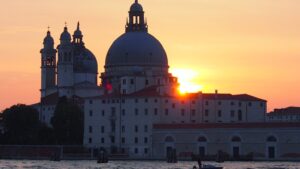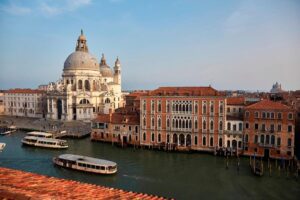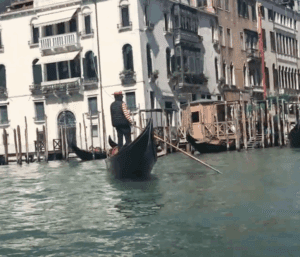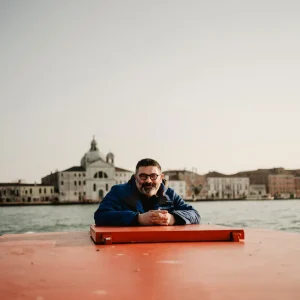Venice doesn’t celebrate Christmas loudly. It celebrates it quietly — in candlelit churches, in the glow of Murano chandeliers, in the warm perfume of pastry shops, and above all, in the delicate and deeply symbolic tradition of the presepio, the nativity scene. While other Italian cities build massive outdoor displays or mechanical moving crèches, Venice hides most of its nativity scenes inside churches, side chapels, cloisters, sacristies and private homes, where they become intimate acts of devotion, memory and beauty.
To understand Venetian Christmas, you must understand its nativity scenes: small worlds shaped by lagoon imagination, Murano craftsmanship, and centuries-old devotion woven into the spiritual fabric of the city. This is the story of Venetian presepi — where they come from, how Venetians create them, where to find the most beautiful hidden ones, and why they remain a cherished tradition even today.
How Nativity Scenes Arrived in Venice
The nativity scene tradition arrived in Venice between the 13th and 14th centuries, inspired by St. Francis of Assisi’s first living nativity. But Venice interpreted the tradition in its own refined and creative way. Instead of grand outdoor tableaux, Venetians preferred smaller, artistic scenes crafted with care and often customised with lagoon details. As a maritime republic with trade routes across the world, Venice adapted biblical narratives to its own culture — incorporating textiles, miniatures, glass, and figurines dressed like local people.
By the 1700s, nativity scenes in Venetian churches became elaborate baroque wonders with carved wood, gold leaf, draped fabrics, and theatrical lighting. And at home, families would set up small presepi on side tables or window ledges, often using pieces inherited across generations.
What Makes Venetian Nativity Scenes Unique
Venetian presepi are smaller, more intimate, and more artistic than those in many Italian regions. Their charm comes from a blend of materials, craftsmanship, and lagoon-inspired creativity.
- Murano glass miniature elements — tiny stars, halos, lanterns or decorative pieces
- Hand-carved wooden figurines from the Veneto tradition
- Fabric drapery made from Venetian brocades and silk scraps
- Details inspired by lagoon life: fishermen, boats, small bridges, even pastel-colored houses
- Painted backgrounds resembling Venetian landscapes
The result is a nativity scene that feels both sacred and deeply local — a blend of Bethlehem and the lagoon.
Where Venetians Hide Their Nativity Scenes
If you wander Venice in December, you might not notice nativity scenes immediately. Venice does not display many outdoors. Instead, they are tucked away where only those who know where to look will find them.
The Nativity Scenes Inside Venetian Churches
Some of Venice’s most beautiful presepi appear inside quiet chapels where locals come to pray during the days before Christmas. Here are some of the most beloved:
- Santa Maria dei Miracoli — one of the most atmospheric settings for a nativity scene, thanks to its marble interior and intimate scale.
- San Zaccaria — known for detailed, artistic displays often created by local confraternities.
- San Giacomo dall’Orio — a warm, welcoming parish with traditional décor and community-crafted nativity scenes.
- San Francesco della Vigna — a setting of deep Franciscan tradition, often hosting symbolic presepi.
- Santa Maria Gloriosa dei Frari — sometimes featuring elaborate setups in cloistered spaces.
Visiting these presepi feels like entering hidden corners of Venice, where history and devotion sit quietly in candlelight. If you want to explore them with deeper context and a local storyteller, the Explore Venice Off the Beaten Path – Orientation Tour is ideal — it leads through authentic neighbourhoods and churches often missed by visitors.
Nativity Scenes Hidden Inside Venetian Homes
In Venetian households, the nativity scene is not a decoration — it’s a family ritual. While Christmas trees have become more common, the presepio remains the heart of home celebrations. Venetians place them:
- on antique wooden credenze
- inside glass cabinets
- on decorated shelves with candles
- in entry rooms near windows, softly lit at night
Many families use presepi passed down for generations. Others buy miniature Murano pieces each year to enrich their scenes — tiny blown-glass angels, stars, or lanterns that catch the Christmas lights beautifully.
How Venetians Build Their Home Nativity Scenes
Venetians start assembling their presepi at the end of November, especially after the Feast of the Madonna della Salute on November 21. It’s a moment when the city symbolically shifts from autumn rituals to winter celebrations.
A typical Venetian family nativity scene includes:
- a cork or wooden base
- a sky painted deep blue (often made from velvet fabric)
- handmade houses resembling lagoon villages
- small bridges or boats
- tiny lights woven into the landscape
- a stable surrounded by local vegetation (bay leaves, rosemary)
- figurines dressed in historical clothing from the Veneto
Children place the angel on December 8, while the baby Jesus is added only on Christmas Eve — a ritual children look forward to every year.
Murano’s Influence on Venetian Nativity Scenes
Murano glass plays a quiet but beautiful role in many Venetian presepi. Some families own miniature figurines blown in glass, while others incorporate glass stars, halos, or decorative elements that reflect candlelight and create a magical effect.
The tradition of using glass to enhance nativity scenes is linked to Murano’s centuries-old identity: turning fire into art, even during winter celebrations. If you want to understand this tradition more deeply, consider exploring artisan workshops on Murano itself, or visiting them through curated lagoon experiences. The guide Venice Like a Local offers excellent insight into how Venetians incorporate craftsmanship into their holidays.
Why the Presepio Matters in Venice Today
In a world of digital screens and commercial Christmas trends, Venice remains attached to quiet rituals. The presepio is not simply a display — it is a reminder of family, community, and spirituality. It expresses values Venetians treasure: beauty, craftsmanship, faith, and memory.
The nativity scene also represents a pause — a moment of serenity in a city visited by millions each year. In December especially, Venice slows down and returns to itself. Visiting its nativity scenes allows travellers to experience the lagoon city not as a postcard, but as a living home with deep traditions.
FAQs
Where can I find the most beautiful nativity scenes in Venice?
Look inside churches such as San Zaccaria, Miracoli, San Giacomo dall’Orio, and San Francesco della Vigna. Many host artistic, intimate nativity scenes during December.
Do Venetians still make nativity scenes at home?
Yes — it’s one of the city’s most cherished Christmas rituals. Families often use handmade figurines, heirlooms and Murano glass miniatures.
When do nativity scenes appear in Venice?
Most are set up after November 21 (Feast of Madonna della Salute) and remain on display through early January.







